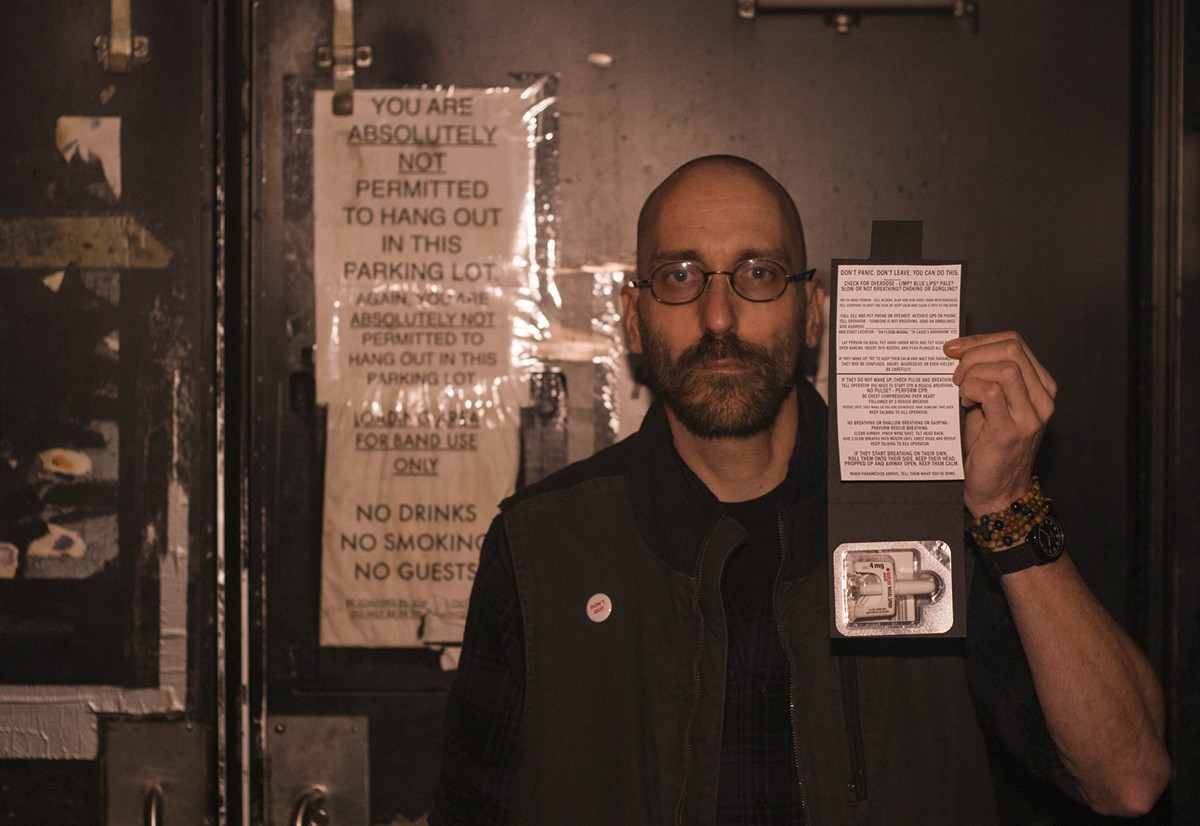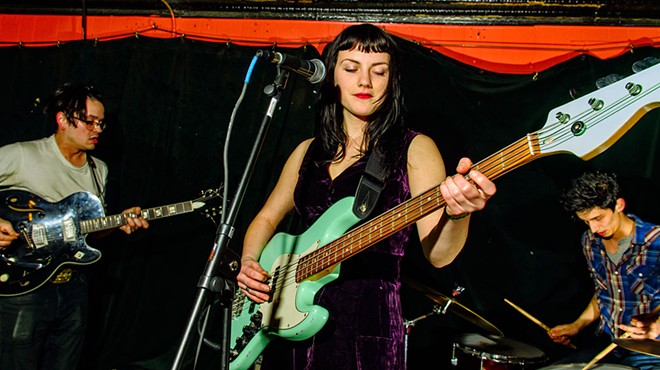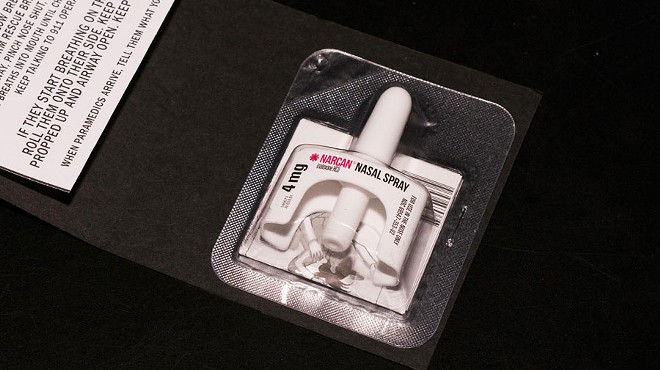"Don't panic. Don't leave. You can do this."
This is not meant as a suggestion or an inspirational wall art mantra. According to Mount Clemens punk rocker and addiction recovery warrior Scott Boyink, these are the first steps in saving a life.
The words are printed on the card that accompanies the Narcan kits which Boyink has been working to provide to Detroit's music venues. Narcan, the brand name for the drug Naloxone, is the emergency antidote that reverses the respiratory depression and sedation associated with opioid overdose, an epidemic that is on the rise in Michigan and across the nation.
"Rock 'n' roll and punk rock have always had tumultuous give-and-take when it comes to substance abuse," Boyink says. "The way we describe it in our own culture, I mean, look at the songs. 'Live fast, die young' — and when people do that, we get upset."
Boyink's goal is to get the kits "anywhere where musicians congregate," he says. "If the venue has a soundboard, I want them to have Narcan. But it's going to take time."
The project comes at a crucial turning point in the opioid crisis, which President Donald Trump categorized as a nationwide health emergency in October.
As with the rest of the nation, Michigan has seen an increase in opioid-related deaths, which have increased exponentially: From 1999 to 2016, 7,300 people have died from an opioid overdose, and more than 60 percent of those deaths have occurred since 2010. To compare: 2012, Michigan opioid related deaths totaled 426, according to information provided by the Michigan Department of Health and Human Services. But by 2016, the number more than tripled with 1,391 total statewide deaths, and 438 in Wayne County alone.
In May, Gov. Rick Snyder authorized a standing order to make naloxone widely available at pharmacies; previously, it was only available to law enforcement and first responders. According to a recent statement from Lt. Gov. Brian Calley, since the standing order, more than half of Michigan pharmacies have registered for naloxone. Registered pharmacies do not require prescriptions to have an order filled. In fact, six months after the standing order, 1,838 unprescribed orders of the medication have been dispensed, and 548 of those just in the past three months.
"As we continue our fight against opioid addiction, this order makes naloxone more accessible for those most likely to need it," Calley said in a statement. "This is a vital step in reducing deaths related to opioid addiction in Michigan. By allowing for shorter response times in emergency situations, we can help save lives."
But despite the efficiency of the registrations, Boyink points out that there are complications when it came to getting his hands on the lifesaving drug — and getting the kits in bars and nightclubs.
"I meant to get this rolling sooner but got stalled in the logistics," Boyink explains.
A former addict himself, Boyink's fundraising efforts started with a series of annual punk shows throughout Hamtramck with his band Steve Harvey Oswald. This particular batch of Narcan for the Hamtramck Music Fest, he says, was purchased with money made from a show from Labor Day 2017. Due to the high retail cost ($150 for two doses, depending on where you go), Boyink says most pharmacies he visits only have one or two doses in stock at any given time, making it hard to distribute large quantities without depleting their inventory.
"It could take them a week to get more if I buy what they have," he explains. "Do I deplete the local stores in my area of their Narcan, just to make this impact?"
Not only is cost a factor, but Boyink says the lack of widespread education, too, has made his mission difficult.
"I started asking around at the local pharmacies in my area and was flabbergasted that many of them — even the larger chains — didn't seem to know that this was supposed to be available without a prescription in Michigan," Boyink says. "I found myself in the strange position of pulling up the [Michigan Department of Health and Human Services] standing order on my phone to educate some of the very retailers that stocked the product."
After his general practitioner refused a prescription, Boyink turned to pharmaceutical online retailer, Adapt Pharma, in attempt to purchase large quantities at wholesale, but was met with opposition.
Boyink says the retailer was at first puzzled at the request. Here was a lone man buying up Narcan, who was not part of any organization. "'You're going to do what with it? Give it to bars? Leave it with strangers?'" he says. "I started to get nervous a bit. Was this even a good idea?" Eventually, the retailer agreed to sell it to him if he could get a prescription blank filled, since the order would travel across state lines.
In the weeks before the fifth annual Hamtramck Music Fest — an event that promises three nights, 21 Hamtramck venues, and 162 bands, Boyink has managed to arm 18 venues throughout metro Detroit — including nine in Hamtramck proper — with Narcan.
"It wasn't a goal of mine initially to time this project out to coincide with Hamtramck Music Fest, but it gave me a good target," Boyink says. "Since Hamtramck is so small yet has so many venues, it made sense to help my friends out there... Since Hamtramck would be flooded soon with festival goers, at least the bars could be a bit more ready for this crisis."
Boyink attended a few different Narcan trainings over the past year and says he distilled the instructions down to what people "would really need to know when the shit hits the fan," he says. The instructions, printed out by Boyink himself and stapled to a makeshift black cardstock box, detail the physical signs of an overdose (blue lips, pale skin, slow breathing, choking or gurgling) and include such blunt lines like, "Tell everyone to shut the fuck up, keep calm, and clear a path to the door. Call 911."
"I had to start adapting the messaging to combat the problem," Boyink says. "I wanted the kits themselves to be super simple, easy to open, and readable, with no-nonsense instructions. I didn't want people to be fumbling with opening boxes and sheets of instructions."
‘I wanted the kits themselves to be super simple. I didn’t want people to be fumbling with opening boxes and sheets of instructions.’
tweet this
Chris O'Droski, a musician and peer recovery coach and coordinator for ENGAGE!, a nonprofit mobile crisis intervention and stabilization program, says he met Boyink years before they both became sober and praises his efforts in the community. Most recently, O'Droski assisted him in taking on peer recovery coach training and recently invited him to join the ENGAGE! team.
"Positive solution-based stories like Scott's inspire others to get out and help whether they're in recovery or not. I'm all for it," O'Droski says. "It keeps people alive. It gives them a chance at a better life. I know some people that are against it, even people who are in the recovery community. From my perspective it helps hospitals, treatment centers, and everyone involved in the field of recovery to give someone who is suffering an opportunity."
Despite the project's seemingly small scale, the impact of Boyink's efforts are already being appreciated throughout the Hamtramck community. Andrea Bonaventura, manager of the Painted Lady Lounge, applauds his mission, as it is one that hits close to home.
"My best friend overdosed a year ago. I had no idea he was using heroin," she says. "He died and it completely destroyed me, and continues to every day. With the Narcan kits, we know now what to look for if someone has fallen out and we know we still need to call EMS. Narcan buys time, but I'm really thankful that we now have that opportunity."
Louie Badalament, the entertainment manager and bartender at New Dodge Lounge, says Boyink is "single-handedly more effective in trying to combat the opioid crisis than anyone in Washington, D.C.," and suggests Congress should hire him if they want to see any real change.
Bonaventura notes that the spirit is very much in line with Hamtramck's do-it-yourself ethos. "A few years ago residents filled potholes on their own dime and with donations because potholes are a real problem here," she says. "So, now we're going to fight heroin. This is just what we do, we try to make some kind of change."
But, he says, it's a start.
"We give Cobain and Thunders a pass," Boyink says. "We call our own 'worthless junkies.' We knew them before things were bad and want them back. We need to fight for that."
And Boyink expects resistance — even from the people he is trying to help. "Addicts do addict things, they're unreasonable and unpredictable," he says. "Add punk rock to the mix and you've got people who don't like authority. When you start telling them what to do, you become one of 'them.' But if everybody knew how to fight through this, we could push this stuff right out of the music scene."
Boyink's distribution efforts are supported by the suicide prevention nonprofit Six Feet Over; more information is available at sixftover.org. Information about opioids is available at michigan.gov/stopoverdoses.
Scott Boyink’s instructions for an opioid overdose:
Don’t panic. Don’t leave. You can do this.
Check for overdose. Limp? Blue lips? Pale? Slow or not breathing? Choking or gurgling?
Try to wake person. Yell in ears, slap and rub chest hard with knuckles.
Tell everyone to shut the fuck up, keep calm and clear a path to the door.
Call 911 and put phone on speaker. Activate GPS on phone, tell operator: “Someone is not breathing, send an ambulance.”
Give address and exact location. “On floor inside,” “In ladies’ bathroom,” etc.
Lay person on back. Put hand under neck and tilt head back. Open Narcan, insert into nostril, and push plunger all the way.
If they wake up, try to keep them calm and wait for paramedics. They may be confused, angry, aggressive, or even violent. Be careful!
If they do not wake up, check pulse and breathing. Tell operator you need to start CPR and rescue breathing.
No pulse? Perform CPR. 30 chest compressions over heart followed by two rescue breaths. Repeat until they wake or you are exhausted. Have someone take over. Keep talking to 911 operator.
No breathing or shallow breathing or gasping: Perform rescue breathing. Clear airway, pinch nose shut, tilt head back, give two slow breaths into mouth until chest rises and repeat. Keep talking to 911 operator.
If they start breathing on their own, roll them onto their side. Keep their head propped up and airway open. Keep them calm.
When paramedics arrive, tell them what you’ve done.








